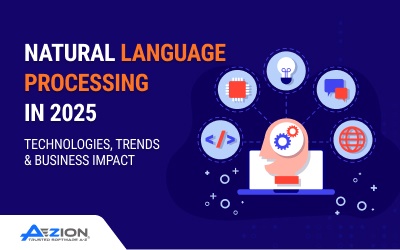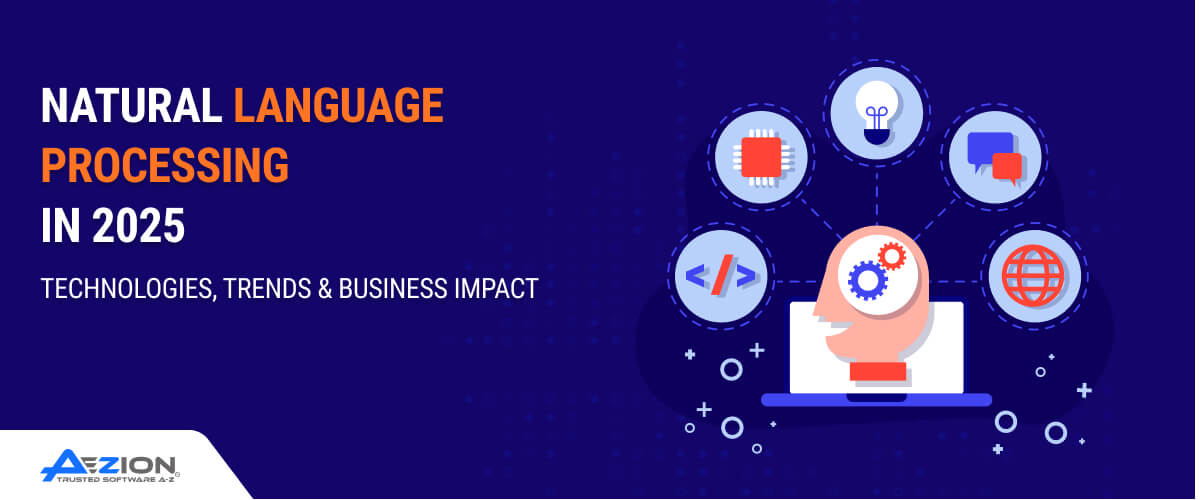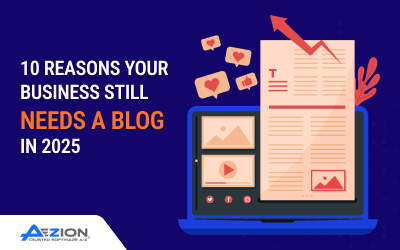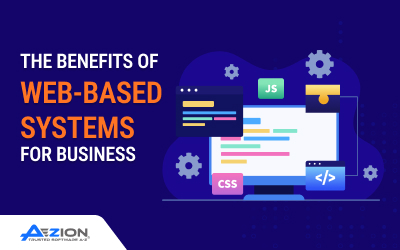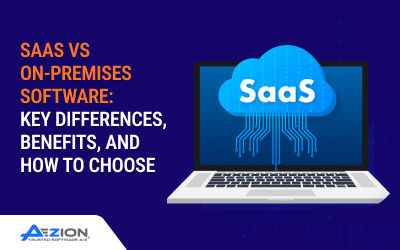Introduction
These days, Natural Language Processing (NLP) has become a crucial part of enterprise AI strategy. Intelligent chatbots, AI-assisted search, always-on transcription services, AI systems with emotion recognition, multi-language interfaces; NLP is literally defining the future of human and machine interaction.
And why is this important today? Because we are now at the lower end of the AI curve and entering a completely new dimension of AI, one in which language is no longer an input but an interface. The advancement of large language models (LLMs), transformer architectures, and multimodal AI systems that build upon NLP can now capture nuance, convey emotion, and recognize context as closely as human levels of communicative ability have ever been achieved.
This blog will see how NLP has evolved along with its current applications, key trends, and implications to organizations to align best and use NLP for every organization’s advantage and innovation engineering strategies.
What Is NLP?
Natural Language Processing (NLP) is a domain of Artificial Intelligence, with the objective of enabling machines to interpret, comprehend, and generate human language. Put differently, NLP seeks to connect human language use and make machine applications for interpreting and comprehending our language.
NLP was initially reliant on rule-based and statistical models to consider both speech and text. Therefore, the systems were relatively strict when dealing with context and ambiguity. Over time, as machine learning and deep learning improved, NLP pushed the limits of what it could do.
Core Concepts in NLP Going Forward:
- Tokenization – The process of separating strings of text into individual words or phrases (tokens), and passing them along to the NLP for processing as text.
- Named Entity Recognition (NER) – Recognition of proper names, organizations, dates, etc.
- Part-of-Speech Tagging – The identification of a word’s syntactic category.
- Parsing & Syntax Analysis – Understanding of sentence structure.
- Named Entity Recognition (NER) – Recognition of proper names, organizations, dates, etc.
- Sentiment Analysis: Finding emotion or opinion in text.
- Language Modeling: Predicting and generating natural language, now the domain of transformer-based models such as BERT and GPT.
Over the last few years, NLP has evolved from single-task models to highly capable foundation models that can multitask on translation, summarization, coding, conversation, and beyond, without task-specific training. This represents a dramatic advance in both generalization and human-like reasoning.
Key NLP Technologies in 2025
By 2025, advancements in the NLP domain will have strengthened and made it more scalable, with increased human-like capabilities. These advances are redefining how machines comprehend language, technology, reasoning, and generation, as well as interact with and create stories for users.
1. Transformer & Reasoning Models
The transformer model continues to drive the NLP landscape. Models such as GPT-4, Claude, Gemini, and Anthropic’s Claude 3, among others, are promising in demonstrating advanced reasoning, memory, summarization, and compliance with more complex instructions, tone, and style of written discourse, as well as commonplace critical thinking abilities.
2. Multimodal & Multilingual Models
Newer models, such as GPT-4 (OpenAI), Gemini 1.5 (Google DeepMind), or Mistral’s Mixtral models, are multimodal – i.e., these models comprehend and generate not only text but also images, audio, and code. They enable real-time chat in dozens of languages. It is possible to deliver NLP to worldwide organizations.
3. Low-Resource Language Optimization
With the increase in language models, the international aspirations of NLP capabilities in supporting the underserved through low-resource language models, such as those with sparse training data (e.g., languages), remain ongoing. Models such as mBERT, XLM-R, and No Language Left Behind (Meta) are advancing cross-lingual learning, adding value to low-resource language models, and taking pride in bringing NLP to underserved communities, opening new markets, and potentially improving digital inclusion.
4. Edge & On-Device NLP
Large models may dominate, but edge-deployable versions, such as DistilBERT and MobileBERT, offer efficient and privacy-friendly NLP features for mobile applications, IoT devices, and offline scenarios.
Top NLP Trends & Research Areas
Over time, innovation has evolved beyond understanding the process of language to recognizing context, intent, and nuance. NLP research areas have started to prioritize improving systems to be more human-aligned, explainable, and context-aware, which are known as the best outcomes for enterprise innovation engineering initiatives. Here are its trends and research areas:
1. Cognitive-Signal Augmentation
Research scientists are combining biological and behavioral signals, such as eye-tracking or sentiment indicators, to train more effective human-alignment language models for NLP. This advances the ability of the systems to recognize human intent, feelings, and attention during real-time collaborations.
2. Explainable NLP
The importance of significant human impact during decision making with NLP systems in healthcare, legal tech, and decision science makes explainability more critical. New methodologies document explainability into NLP systems, addressing black-box behavior and providing end-users with confidence in the system being used.
3. Pragmatics and Contextual Understanding
The attention of NLP is turning from syntax and sentence-level understanding to pragmatics, or how meaning varies due to tone, context, and cultural cues. This transition could improve chatbot accuracy, sarcasm detection, and emotional intelligence for responding.
4. Emotion and Sentiment Evolution
NLP can now recognize intimate emotional states of human behavior, for example, frustration vs confusion. Models trained on more extensive datasets with culturally diverse characteristics improve sentiment analysis in multiple languages with multiple demographics and use cases.
5. Quantum NLP (QNLP)
In experimental phases, QNLP investigates how quantum computing may transform language modeling, particularly for computationally complex or context-rich tasks. Startups and research institutions are developing quantum-augmented language embeddings in the form of prototypes.
Real World Applications Across Industries
Natural Language Processing has transitioned from the lab to production, reshaping the way companies conduct business, interact with customers, and make decisions. In 2025, NLP solutions driven by innovation engineering principles will extend to almost all industries:
1. Healthcare & Mental Health
- NLP assists in analyzing clinical notes, patient histories, and voice commands to aid in quicker diagnoses and compliance reporting.
- Emotion-aware chatbots aid in the early detection of mental illness through emotional distress in speech patterns.
2. Customer Service & Virtual Agents
- AI assistants now support near-human dialogue, responding to sophisticated queries through voice, text, and email.
- NLP-based systems learn from past interactions to improve response precision and tone matching constantly.
3. Real-Time Subtitling & Translation
- Multilingual NLP models enable real-time translation and subtitling during international meetings, learning content, and live streams.
- Tools such as YouTube, Zoom, and Teams incorporate NLP to provide auto-captioning in 50+ languages.
4. Code & Software Development
- Developers utilize NLP applications such as GitHub Copilot or CodeWhisperer to write, debug, and document code using natural language instructions.
- API descriptions and documentation are automatically created with the help of summarization.
5. Smart Search and Content Discovery
- Corporate search systems utilize NLP to recognize the intent of users, serving context-aware and personalized results.
- E-commerce and media businesses serve smarter recommendations by reading product reviews, comments, and customer queries.
6. Website NLP Interfaces
- Websites are becoming conversational, where users can frame natural questions rather than navigate menus.
- “NLWeb” (Natural Language Web) is becoming a notion, based on intuitive, query-driven navigation and content creation.
Technical Innovations & Tools
There are heavy-duty tools and frameworks enhancements behind the scenes of contemporary NLP that enable today’s developments.
- Hugging Face Transformers: The de facto library for building transformer-based models such as BERT, RoBERTa, and GPT variants.
- spaCy: Efficient but highly capable, great for production NLP pipelines.
- TensorFlow & PyTorch: Continue to enable bespoke model training and serving across platforms.
- LangChain & LlamaIndex: Most commonly used to create context-aware NLP applications, particularly in RAG (Retrieval-Augmented Generation) pipelines.
Challenges While Working with NLP
Despite impressive progress, NLP in 2025 still faces critical challenges. These challenges dictate not only how models are built but also how they’re responsibly applied in the real world.
1. Low-Resource Language Coverage
Although multilingual models are better, most languages, particularly dialects and less-represented regional languages, still require high-quality training data. This causes digital disadvantage and restricts the global applicability of NLP.
2. Model Interpretability
Large language models tend to act like “black boxes” with no easy way to track how decisions or responses are generated. This restricts trust and is a problem in high-stakes uses such as finance, law, or healthcare.
3. Misinformation
LLMs are still “hallucinating” and producing confident-sounding but wrong or made-up facts. Minimizing these mistakes is crucial when factual accuracy is required, such as in news reporting or legal briefs.
4. Environmental Impact
Training and running giant language models consume vast computational resources and contribute to carbon footprints. The field is researching green AI projects, including model distillation and energy-efficient hardware, to mitigate this.
5. Real-World Reliability
NLP systems tend to fail when used in dynamic settings such as conversational text, technical jargon, or sarcasm. Current research is centered around robustness, showing how to make NLP models more resilient in edge cases.
The Future of NLP
In the future, NLP will continue to be further embedded in how humans interact with digital systems, unifying language, vision, sound, and emotion into fluid AI experiences.
Contextual and Emotionally Intelligent Systems
NLP is moving towards affect-aware, empathetic, and personality-aware systems. These systems will not just know what users say but how they feel, facilitating human-like interactions in healthcare, education, and customer support.
Conversational Interfaces Everywhere
Natural Language is rapidly becoming the new UI. From querying business dashboards to navigating a website, or even coding, NLP-facilitated interfaces will enable users to accomplish things simply by asking.
Quantum-Accelerated NLP
QNLP research is breaking new ground for ultra-efficient models that can handle highly contextual, ambiguous, or multi-modal inputs at scale. Quantum acceleration, although still experimental, may solve some of the most challenging NLP bottlenecks in today’s era.
Tightly Integrated Human-AI Collaboration
NLP will not only automate, but it will also augment. Applications such as AI co-pilots, voice-activated productivity assistants, and knowledge management systems will eliminate the distinction between human input and machine completion, releasing new levels of productivity and creativity.
Industry-Specific LLMs
There is an increase in domain-specialized NLP models trained for legal, finance, healthcare, or manufacturing environments. Such models are more accurate, compliant, and relevant compared to general-purpose LLMs.
Final Thoughts
As seen in the blog, Natural Language Processing has become an enterprise standard. We are no longer just creating smart chatbots and voice assistants; we are transforming the way organizations process data and interact with technology.
The shift has occurred from rule-based parsing to transformer-based reasoning and from single tasks to multimodal understanding, providing a revolution in that, on some level, machines create meaning about the human world. There is also an important distinction that organizations can build NLP capabilities while staying true to ethical design, transparency, and inclusivity with the help of innovation engineering solution providers.
Due to a very slight difference between natural and artificial, organizations seeking a long-term view and looking to deploy NLP will find a competitive market and commercialization advantages, thereby improving decision-making, enhancing the customer experience, and establishing new opportunities at every customer touchpoint and engagement.
Frequently Asked Questions (FAQ)
What is a transformer model, and why is it still at the heart of NLP?
Transformer models transformed NLP by allowing parallel processing and attention mechanisms that concentrate on contextual word relationships. They drive the majority of cutting-edge models, such as GPT-4, BERT, and Claude, due to their scalability and versatility.
What is being done to reduce bias and improve explainability in NLP?
Researchers and developers use bias detection tools, inclusive datasets, and interpretability systems (such as SHAP or LIME). Regulation requirements and ethical guidelines are forcing organizations to be a lot more transparent about how NLP systems function and what their decision-making processes look like.
What is Quantum NLP (QNLP), and when can it be used?
QNLP is investigating the potential for quantum computing to improve NLP, with two main focuses: context understanding and combinatorial optimization. The field is now considered experimental, but potential commercial applications may be possible later this decade as quantum hardware becomes more widely available.
How can my company get started with NLP?
Start with a clear use case such as sentiment analysis, document summarization, or automating customer service. Utilize established models such as open-source or API-based solutions and collaborate with an experienced AI engineering company like Aezion to customize, deploy, and scale solutions responsibly.
